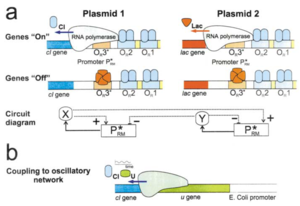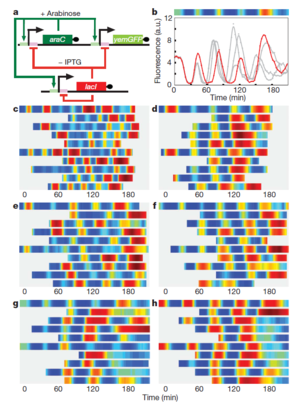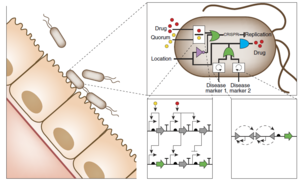Computer Logic in Microbial Systems: Difference between revisions
No edit summary |
No edit summary |
||
| Line 6: | Line 6: | ||
<br> | <br> | ||
<br> | <br> | ||
Synthetic biology is a quickly evolving field that combines the sciences of molecular biology and biochemistry with engineering. One major task for synthetic biologists is harnessing cell’s innate ability to perform tightly concerted metabolic processes in order to produce molecules of industrial and medical relevance. In other words, one goal of synthetic biology is to create a programming language for cellular processes that can be altered with great precision to generate microbes with specific functions. Applying computer logic to living systems is challenging, as gene regulation is highly sensitive to the environment and requires a tightly controlled balance of regulatory factors< | Synthetic biology is a quickly evolving field that combines the sciences of molecular biology and biochemistry with engineering. One major task for synthetic biologists is harnessing cell’s innate ability to perform tightly concerted metabolic processes in order to produce molecules of industrial and medical relevance. In other words, one goal of synthetic biology is to create a programming language for cellular processes that can be altered with great precision to generate microbes with specific functions. Applying computer logic to living systems is challenging, as gene regulation is highly sensitive to the environment and requires a tightly controlled balance of regulatory factors<ref name = Brophy2014/>. Nonetheless, several methods have been developed to translate logical operators into genetic circuits.<br> | ||
<br>Programmable cells have myriad applications to industry and medicine. As an example, a strain of Yersinia pseudotuberculosis was modified to invade cancerous cells in response to environmental conditions< | <br>Programmable cells have myriad applications to industry and medicine. As an example, a strain of Yersinia pseudotuberculosis was modified to invade cancerous cells in response to environmental conditions<ref name = Anderson2006/>. In this study, <i>Y. pseudotuberculosis</i> was equipped with synthetic genetic circuits that allowed it to detect changes in several environmental factors. In the presence of certain environmental conditions (such as high cell density and hypoxia), the strain expressed a protein that allowed it to invade mammalian cells (<b>Figure 1</b>). Applications like this could be used to create synthetic organisms capable of accomplishing highly specific tasks such as targeting specific tissues or compounds. Here, we will discuss several advancements in synthetic biology techniques used to program cells. By translating logical operations to genetic circuits, it is theoretically possible to design a cell to target a specific tissue or pathogen for drug delivery<ref name = Brophy2014/>. <br> | ||
Revision as of 02:42, 25 April 2017
Introduction

By Jeremy Moore
Synthetic biology is a quickly evolving field that combines the sciences of molecular biology and biochemistry with engineering. One major task for synthetic biologists is harnessing cell’s innate ability to perform tightly concerted metabolic processes in order to produce molecules of industrial and medical relevance. In other words, one goal of synthetic biology is to create a programming language for cellular processes that can be altered with great precision to generate microbes with specific functions. Applying computer logic to living systems is challenging, as gene regulation is highly sensitive to the environment and requires a tightly controlled balance of regulatory factors[2]. Nonetheless, several methods have been developed to translate logical operators into genetic circuits.
Programmable cells have myriad applications to industry and medicine. As an example, a strain of Yersinia pseudotuberculosis was modified to invade cancerous cells in response to environmental conditions[1]. In this study, Y. pseudotuberculosis was equipped with synthetic genetic circuits that allowed it to detect changes in several environmental factors. In the presence of certain environmental conditions (such as high cell density and hypoxia), the strain expressed a protein that allowed it to invade mammalian cells (Figure 1). Applications like this could be used to create synthetic organisms capable of accomplishing highly specific tasks such as targeting specific tissues or compounds. Here, we will discuss several advancements in synthetic biology techniques used to program cells. By translating logical operations to genetic circuits, it is theoretically possible to design a cell to target a specific tissue or pathogen for drug delivery[2].
Logic Gates in Biological Context


tion.
Counting and Memory Function Using Invertases

Construction of Complex Logic


Oscillating Synthetic Gene Networks


Circuit Interactions with the Host Cell
Conclusion

References
- ↑ 1.0 1.1 JC, Clarke EJ, Arkin AP, Voigt CA. Environmentally Controlled Invasion of Cancer Cells by Engineered Bacteria. (2006). JMB 355: 619 – 627. doi:10.1016/j.jmp.2005.10.076.
- ↑ 2.0 2.1 2.2 2.3 Brophy JAN, Voigt CA. Principles of Genetic Circuit Design. (2014). Nature Methods 11(5): 508 – 520. DOI:10.1038/NMETH.2926.
- ↑ 3.0 3.1 3.2 http://www.nature.com/nature/journal/v469/n7329/abs/nature09565.html Tamsir A, Tabor JJ, Voigt CA. Robust multicellular computing using genetically encoded NOR gates and chemical ‘wires’. (2011) Nature 469: 212 – 215. doi:10.1038/nature09565.
- ↑ . Friedland AE, Lu TK, Wang X, Shi D, Church G, Collins JJ. Synthetic Gene Networks that Count. (2009). Science 324(5931): 1199 – 1202.
- ↑ https://journals.aps.org/prl/abstract/10.1103/PhysRevLett.88.148101 Hasty J, Dolnik M, Rottschafer V, Collins JJ. Synthetic Gene Network for Entraining and Amplifying Cellular Oscillations. 2002. Physical Review Letters 88(14) 148101.
- ↑ http://www.nature.com/nature/journal/v456/n7221/full/nature07389.html Stricker J, Cookson S, Bennett MR, Mather WH, Tsimring LS, Hasty J. A fast, robust and tunable synthetic gene oscillator. 2008. Nature 456(27) 07389.
Authored for BIOL 238 Microbiology, taught by Joan Slonczewski, 2017, Kenyon College.
